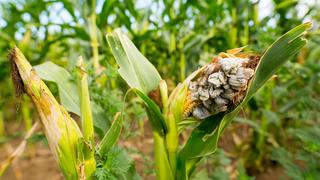Cracking the Code on Corn Smut
Research on Ustilago maydis, a biotrophic pathogen that infects corn, could have implications for understanding and preventing other plant and human disease, a new study finds.
 Ustilago maydis, or corn smut, is a fungus that infects corn, presenting itself in large bluish-black tumors. In Latin American cultures, it’s considered a delicacy called huitlacoche.
Ustilago maydis, or corn smut, is a fungus that infects corn, presenting itself in large bluish-black tumors. In Latin American cultures, it’s considered a delicacy called huitlacoche.
Plant pathogens like rusts and smuts threaten to destroy billions of dollars’ worth of crops each year. While some plants are able to stave off these parasites through natural immune response, others fall susceptible to stealth pathogens, which trick the host into sending nutrients to the fungus, ultimately enabling it to overtake the plant. Understanding how these pathogens work is at the center of a recent study published in the journal Nature Microbiology, co-authored by Karen Snetselaar, Ph.D., professor emerita of biology at Saint Joseph’s University.
For the last decade, Snetselaar and a team of researchers at the Max Planck Institute for Terrestrial Microbiology have been studying maize plants infected by the biotrophic pathogen Ustilago maydis, or corn smut. Typically when a plant is infected by a pathogen, it activates a hypersentive response, killing off a few of its own healthy cells so the pathogen can’t grow or spread.
Ustilago maydis, however, has found a way to evade this response, suppressing the corn’s immunity and causing it to grow bigger than normal. The result? Large bluish-black tumors of plant and fungal matter on the corn’s ears and leaves.
“At a later stage, the fungus will turn on the plant and gobble up all the stuff that’s there,” adds Snetselaar. “It’s an elaborate crosstalk between the two organisms, and that’s what makes it really interesting.”
Preventing a fungal infection, however, isn’t the team's endgame. Snetselaar explains that corn breeders have figured out a way to select varieties of corn that aren’t as susceptible to the fungus.
“It’s more about understanding how it works so that we can apply what we learn to other pathogens that are more economically important,” she says. “There are also some [pathogens] that are not so distantly related and cause human disease, so it’s definitely important to understand.”
Only as Strong as its Weakest Link
When Ustilago maydis infects corn — and as a biotrophic pathogen it requires its host to be alive to survive — it releases a collective of seven proteins called effectors that cause the plant to act in a certain way.
“So for example, when the plant cells divide more than normal and send sugars to the location of the tumor, it’s these effectors that the fungus produces that trick the plant into doing that,” explains Snetselaar.
Regine Kahmann, Ph.D., German microbiologist, recently retired director of the Max Planck Institute and one of the study’s co-authors, hypothesized that these effector proteins (also referred to as STP or stop proteins) work together to form a channel that allows the fungus to communicate with the plant cells.
“We know of a number of different channels like this between pathogens and their host, but this was a completely different, novel channel,” says Snetselaar. “There were different genes and it was organized completely differently than we’d seen before.”
What the researchers also uncovered was that if one of the seven effectors is missing, the fungus can no longer infect its host. Proving this definitively, however, is another story.
“It has to do with the fact that you’re working with two organisms. To say that if you blocked the channel, that that was the reason the other molecules didn’t get through turned out to be difficult to do,” Snetselaar explains. “If you disable a pathogen, the plant makes a hypersensitive response and its cells start to die as a defense. And so, you don’t know if that’s because of the fungus [or the disabled channel].”
Many Hands Make Light Work
Sequencing and observing how Ustilago maydis interacts with its host is meticulous work that requires the use of a transmission electron microscope — a tool Snetselaar acquired through an NSF grant early in her tenure at Saint Joseph’s.
Over the years, she’s worked with a number of students in her lab on this novel research, many of whom were interested in medicine and diseases. Because the fungus can’t infect humans, it’s safe to study and presents interesting symptoms including its cancer-like tumors.
Adeline Fagan, M.D., a 2014 graduate who passed away from COVID-19 last year, was one of those students.
“Addie was the one who tested the labeling method we used, because in the beginning, we didn’t know if it was going to work,” Snetselaar says. “It was technically very difficult work and I made sure she was listed in the acknowledgements on the paper.”
The research has already resulted in a recently filed fungicide patent in Europe, which will have applications for the agriculture industry. As the team continues to uncover exactly how Ustilago maydis works, it could have implications for understanding how other pathogens work, too.
“If its membrane transportation system is widespread among other organisms, it could have applications for plant and human diseases and even the drugs that treat them,” Snetselaar says.



